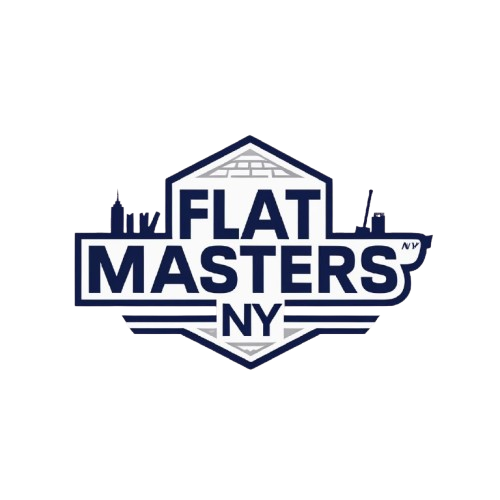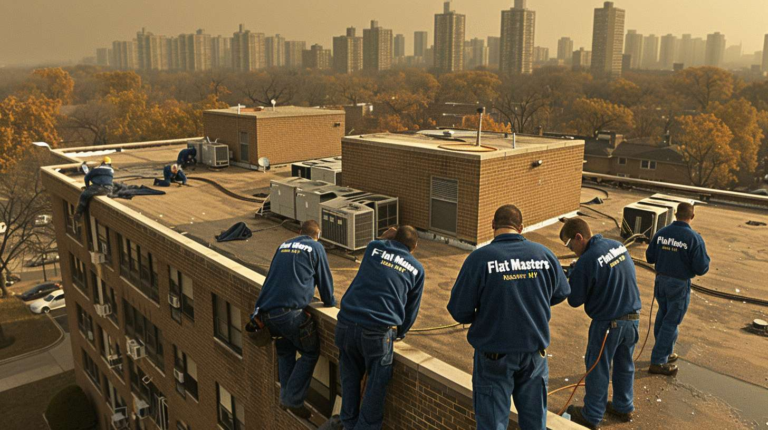What Is a Flat Roof Made Of? Your Complete Material Guide
After thirty-two years installing flat roofs across Queens, I can tell you that most property owners have no clue what's actually above their heads. And honestly, I don't blame them - the roofing industry doesn't exactly make this stuff easy to understand.
Flat roofs are primarily made of membrane materials like EPDM rubber, TPO, modified bitumen, or built-up roofing systems, installed over insulation and decking. But here's what really matters for your Queens property: the specific material choice can make or break your roof's performance in our harsh Northeast weather.
The Main Flat Roof Membrane Materials
Let me break down what your flat roof is actually made of, starting with the most common materials we install here in Queens.
EPDM (Ethylene Propylene Diene Monomer) - This is synthetic rubber, and it's been my go-to for residential flat roofs for decades. The material comes in black or white sheets, typically 45 or 60 mil thickness. Last month we installed a 60-mil EPDM system on a house in Elmhurst that should last 25+ years easy.
TPO (Thermoplastic Polyolefin) is the newer kid on the block. White, heat-welded seams, and honestly, it's becoming more popular than EPDM for good reason. The reflective surface keeps cooling costs down during those brutal Queens summers. We've been installing more TPO systems lately - just finished three buildings on Northern Boulevard last week.
Modified bitumen is basically asphalt with added polymers to make it more flexible. Think of it as the evolution of the old tar roofs. It comes in rolls and can be torch-applied or cold-applied. I still see plenty of modified bitumen roofs in Astoria that are 20+ years old and holding strong.
Built-Up Roofing Systems (BUR)
This is the old-school method - multiple layers of asphalt and reinforcing fabric, topped with gravel or cap sheet. Your grandmother's flat roof was probably BUR. We don't install many new BUR systems anymore, but I still maintain dozens across Queens. The material consists of alternating layers of bitumen and reinforcing plies, creating what we call a "membrane."
Here's something most contractors won't tell you: BUR systems can actually outlast some modern membranes if they're properly maintained. I've got a customer in Corona with a 35-year-old BUR roof that's still watertight.
What's Under Your Roof Membrane
The membrane is just the top layer. Understanding what your flat roof is made of means knowing the entire system:
- Roof deck (usually plywood, OSB, or concrete)
- Vapor barrier (when needed)
- Insulation (polyiso, EPS, or XPS boards)
- Cover board (protection for the insulation)
- Membrane system
The insulation is crucial - most Queens buildings use polyisocyanurate (polyiso) boards, typically 2-4 inches thick depending on energy codes. Without proper insulation, your heating bills will kill you, and the membrane won't perform properly.
Specialty Flat Roof Materials
PVC membranes are similar to TPO but typically more expensive and chemical-resistant. I mainly use PVC on commercial buildings where there might be grease or chemical exposure. The welded seams are incredibly strong.
Liquid-applied membranes are growing in popularity for repairs and re-roofing. These are essentially coatings that cure into a seamless membrane. Great for complex roof shapes or when you can't tear off the existing roof.
Metal roofing on flat applications - yes, it exists. Standing seam metal can be installed on low-slope applications, though I wouldn't call it truly "flat." More common on commercial buildings.
How Flat Roofs Are Actually Made
The installation process determines how well your flat roof will perform. Here's how we build a proper flat roof system at Flat Masters NY:
First, we evaluate the existing deck structure. Most Queens buildings have either wood decking or concrete. The deck needs to be solid, properly sloped (yes, flat roofs need slope - minimum 1/4 inch per foot), and dry before we start.
Next comes the insulation installation. We typically use polyiso boards in multiple layers with staggered joints. This prevents thermal bridging and creates a solid, even surface. The insulation gets mechanically fastened to the deck.
Then we install the membrane. For EPDM, we either fully adhere it with contact cement or mechanically attach it. TPO and PVC get heat-welded at all seams - that's what makes them watertight. Modified bitumen gets torched down or cold-applied depending on the specific product.
Regional Considerations for Queens Flat Roofs
What your flat roof is made of needs to handle our specific climate. The salt air from the East River and Long Island Sound accelerates metal corrosion. Our freeze-thaw cycles are brutal on membrane materials. And those summer heat islands in Queens can push roof surface temperatures over 180°F.
That's why I typically recommend white or light-colored membranes here. The energy savings alone usually pay for the material upgrade within five years. Plus, many of our customers qualify for Con Ed rebates on cool roof installations.
Snow loading is another factor. A typical Queens flat roof needs to handle at least 30 pounds per square foot of snow load, more for certain areas. This affects both the structural deck and insulation choices.
Quality Indicators in Flat Roof Materials
Not all flat roof materials are created equal. Here's what separates quality systems from cheap installations:
Membrane thickness matters. I never install anything thinner than 45 mil EPDM or TPO on residential projects. Commercial buildings get 60 mil minimum. The extra thickness costs maybe $0.50 per square foot but adds years to the roof life.
Insulation R-value should meet or exceed local energy codes. In Queens, we typically install R-25 to R-30 systems. Cheap contractors skimp on insulation thickness - don't let them.
Proper flashing materials are critical. All penetrations, edges, and transitions need compatible flashing. Mixing incompatible materials causes premature failures.
Maintenance Requirements by Material Type
Different flat roof materials have different maintenance needs. EPDM requires annual inspections and occasional seam repairs. TPO needs regular cleaning to maintain its reflective properties. Modified bitumen benefits from periodic re-coating.
I tell all my customers: regardless of what your flat roof is made of, plan on annual professional inspections and minor repairs. It's way cheaper than a full replacement every 15 years instead of 25+.
Look, I've been doing this since 1991, and I've seen every flat roof material succeed and fail. The material matters, but proper installation and maintenance matter more. If you're trying to figure out what your existing flat roof is made of, or planning a new installation in Queens, give us a call at (917) 994-7618. We'll take a look and give you straight answers about your specific situation.
At Flat Masters NY, we've installed over 3,000 flat roofs across Queens, and we know what works in our climate. Whether your building needs EPDM, TPO, modified bitumen, or a specialty system, we'll recommend the right materials for your specific application and budget.


